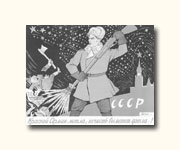
P
r
e
f
a
c
e
2
Dieter Vorsteher
The Image of America as the Enemy
in the Former GDR
2. Setting the scene
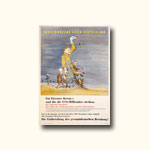 Among the tools used by the SED (Socialist
Unity Party) to spread its political message and mobilize East German
society were mass meetings, people's congresses, collections of signatures
and demonstrations. Political parades were accompanied by placards and
picture posters, flags and portraits of political leaders, figures in
fancy dress and politically-inspired diagrams, as the GDR drew on the
agitprop culture of the Communist Party and the street theatre of the
Twenties. Collage, photomontage, quotes from the press with documented
claims, caricatured representations of political opponents and the "shining
figures" of the victorious working class were recurring elements
of the political posters of those years. The Third Reich had also used
similar didactic methods, if not subject matter, as a basis for its propaganda
methods in the Thirties.
Among the tools used by the SED (Socialist
Unity Party) to spread its political message and mobilize East German
society were mass meetings, people's congresses, collections of signatures
and demonstrations. Political parades were accompanied by placards and
picture posters, flags and portraits of political leaders, figures in
fancy dress and politically-inspired diagrams, as the GDR drew on the
agitprop culture of the Communist Party and the street theatre of the
Twenties. Collage, photomontage, quotes from the press with documented
claims, caricatured representations of political opponents and the "shining
figures" of the victorious working class were recurring elements
of the political posters of those years. The Third Reich had also used
similar didactic methods, if not subject matter, as a basis for its propaganda
methods in the Thirties.
The early East German poster - by "early" we mean the post-war
period up to the mid Fifties-draws an the anti-capitalist elements of
three picture sources:
the Weimar Republic, the USSR and the Third Reich. But what proved fatal
for the political poster in the GDR was that it borrowed wholesale the
"anti-Semitic" physiognomies of Nazi propaganda to depict and
defame the "capitalist warmongers". Capitalism and "usury"
were still given a "Semitic" face. Equally fatal for their acceptance
by a German audience was that the SED's posters not only looked like the
poster art of the Soviet Union, but poster designs were actually supplied
by the Kukryniksy artists' collective in Moscow. This time, however, it
was not Hitler's fascism and its leaders which were "world enemy
number one", but supposed American imperialism. The same visual language
which had been used in the USSR to fight German fascism, was now turned
against the USA - yesterday's alliance partner.
In borrowing elements of form and iconography in this way, the East German
"Office for Information and Agitation" put their faith in avant-garde
poster art since 1920 (and avant-garde was what the representatives of
the "first workers' and peasants' state" an German soil took
themselves to be). In this, however, they proved to be politically insensitive:
the office for state agitprop served to encourage the west's remonstrations
about the "Sovietization of the GDR". Furthermore, the similarities
depicted between Stalinist dictatorship and German fascism supplied ammunition
to those who equated "red dictatorship" with "brown dictatorship"
and called for the fight against totalitarianism.
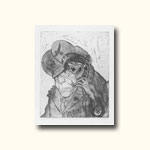
Just as the pictures were subjected to neither "de-Nazification"
nor "de-Stalinization", the words an the posters likewise remained
rooted in the language of the Third Reich, with no trace of humanization
or democratization in relation to the political opponent. The talk is
of "preventing" and "fighting", "slaying"
and "driving out", "destroying" and "exterminating",
"seizing" and "shattering". The class enemy is squeezed
and tormented, pushed and crushed, and finally driven out of the country.
What is proclaimed here as "building up socialism" is more like
a process of cleansing the country of "vermin" and misfits.
After 1947/48 America and her "German agents" are the unmistakable
targets of this political agitation. The figure of the bourgeois and war
profiteer of the Twenties, familiar to usfrom the caricatures of Georg
Grosz, reemerges, with the addition of dollar notes and various inscriptions
such as "Marshall Plan". Once the USSR and countries of eastern
Europe had rejected the Marshall Plan, the posters once again evoke the
antagonism between capitalism and socialism. The shady characters and
gangsters pursue their capitalism under cover in the Soviet zone/GDR a
country imbued with the spirit of reconstruction and peace - in order
to damage the socialist economy. But it is not only the GDR which is harmed
by these "American agents"; the whole of Germany suffers from
them, particularly the defenseless Federal Republic, where capitalism
is spreading unchecked, abetted by Adenauer (CDU), Schumacher (SPD) and
Ollenhauer (SPD). Already the talk of a "European Defense Community"
(EDC) reveals blatant militarism. America rehabilitates the fascists and
makes common cause with them. The Symbols "US" and "SS"
(abbreviation for the state security service in the Third Reich) an the
clothing of former members of the "fascist Wehrmacht" show both
their provenance and their new masters. The rearmament of the Federal
Republic can only serve the purpose of carrying out fascist plans of conquest
of the USSR in the service of America. The West Germans will be impoverished
by US capitalism and exploited by the Americans as cannon fodder in their
wars of conquest. Aggressive capitalism is followed inevitably by militarism
and imperialism. Mankind is on the brink of a third world war. This briefly
is the message of the picture histories collected together here.
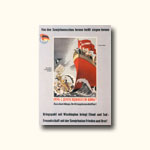
Whether or not these statements are true in the context of the power politics
of those years is not relevant here. In any case, as "images of the
enemy" they do not measure up to acutal events. The fears they created,
on the other hand, certainly provoked decisions and influenced actions.
The pictures prepared the ground for a state of bitter seriousness. They
may have been fictional, but they playes their unpardonable part in history
after 1945. Whether the Warsaw Pact and Nato were oriented more to defense
or to attack, which of the two represented the greater menace, is a question
for military history, and because of the success of pax atomica over the
years, thankfully academic.
The partition of the world in post-war Europe replenished the arsenal
of enemy images. The posters with their pictures were not used to debate
different political opinions; they provided a platform for a lifeor-death
struggle. Thus the posters and caricatures contributed to the climate
of mistrust and political persecution in the GDR. They prevented the democratization
process because they supplied the GDR with arguments to bring the justice
system into line. From the outset jurisprudence was sacrificed to a fictitiousfight
against "fascism" and "American imperialism". This
sabotage of the democratic renewal of Germany played a significant part
in establishing state dictatorship in the Soviet zone/GDR. Pictures and
words showing how the enemy was to be treated were an incitement to informing
and class warfare at home. In the final analysis the practises imputed
to the enemy in the posters anticipated legalized "measures"
against the country's own people.
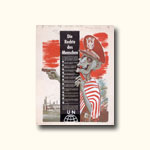
But what do "American agents" and their "German lackeys"
look like- What form does the "capitalist west" take- Its face
is like the head of Janus. We See a fat, greedy freeloader living in luxury
at the expense of the German people. This picture works for as long as
the occupation statute makes independent political life in Germany impossible
and until the upturn in the economy. At this time the GDR still put its
faith in the solidarity of the German working classes, the only people
capable of shaking off the yoke of the exploiters (i. e. the victorious
western powers). There was little innovative about this picture. For over
500 years exploiters have been depicted in caricatures as lazy and gluttonous
figures. What was more decisive for the political struggle in the GDR
was the "true face of the class enemy."
In reality the enemies of the working class are pathetic figures, their
faces indelibly marked by their criminal mentality. They populate the
world as deformed apparitions. Having lost their human countenance, they
approach the final battle against the heroes of the working class as vermin
or dwarves. The former are strong and healthy, looking to the future in
the certainty of victory. It is as though an inferior race the capitalists
and imperialists - were competing against the superior stock of the socialists
and communists. An enfeebled species from the dawn of evolution, doomed
long ago to extinction, is swept from the earth by the hand of the working
class. lt is an evolutionary forecast which is described in detail in
Marxist-Leninist scientific theory: the working class will outlive the
bourgeoisie. Not only that, it is also the better part of humanity, to
whom the future belongs.

This inevitability encouraged the socialist leaders in their certainty
that victory would be theirs. The posters promise victory in the future,
an attitude which was reckless in terms of the conflicts of the post-war
period since it was programed to a policy of holding an rather than finding
solutions. Although the USSR (and all the eastern-bloc countries) knew
they could not compete economically with the western industrial nations,
they became involved in competition between the systems while they waited
for the right moment in history for what they viewed as the inevitable
confrontation. They were kept going by their certainty that capitalism
would soon outlive its usefulness and would destroy itself through its
own contradictions. Soviet foreign policy had nothing to do with being
ready to compromise and solve the conflicts between two opposing systems;
it was all about sitting out the problems of the present. At some time
or other there would be a better starting point. One way or another the
proletariat would end up as the gravediggers of capitalism. Certain that
the future already belonged to it, socialism was not all that concerned
about shaping the present. In the end this excessive utopianism robbed
it of its future, if indeed it ever had one. A glance at the image of
America as the enemy, as depicted in posters from the early GDR, reveals
how the socialist countries set about resolving the east-west conflict.
Their method involved naked Darwinism: the mighty proletariat destroys
its deformed and degenerate political enemies. We should perhaps be grateful
that for most of this time the USSR suspected it was inferior to the west
in military and economic terms and did not dare to carry out its historic
mandate.
Impressum :: Further information :: Guestbook :: Shop :: Home
